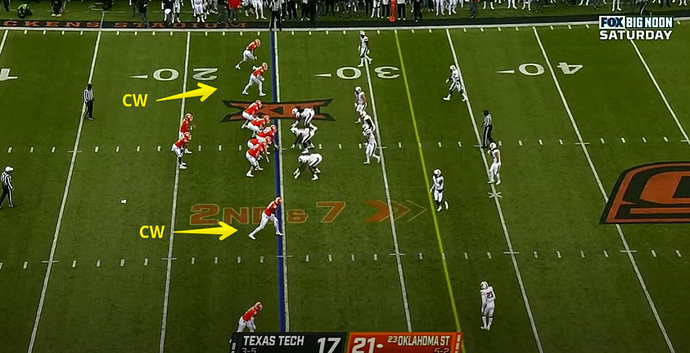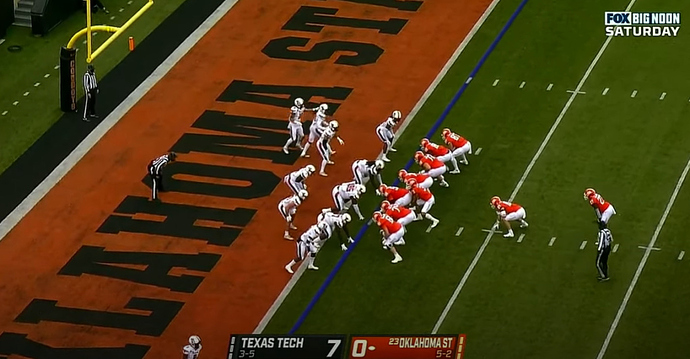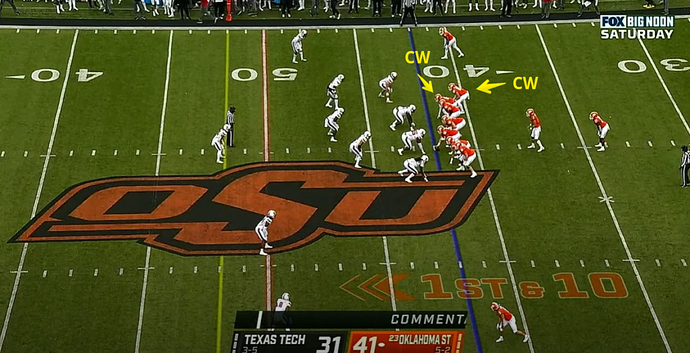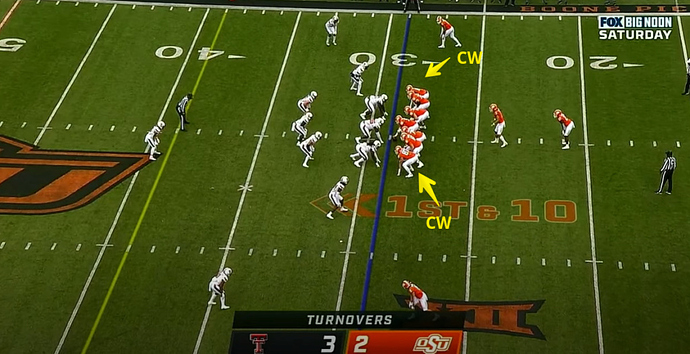From the inimitable @dustinragusa24, a three-part film review of OSU’s offensive schemes it used to defeat Texas Tech over the weekend.
Oklahoma State bounced back from their Bedlam loss with a win against Texas Tech in the Cowboys' final home game of the season. The OSU offense went for over 500 total yards for just the third time this season, and their 6.1 yards per play against the Red Raiders was their second highest average of the year.
Most of these yards came by way of JUCO transfer running back Desmond Jackson, who recorded 235 yards on 36 carries (6.5 yards per carry) and found the endzone three times. In addition, Spencer Sanders tallied 222 yards through the air and an additional 76 on the ground. On the other side of the ball, the defense let up some big plays, but managed to help out in the scoring department with a interception return for a touchdown. The Cowboy special teams unit also got involved in the touchdown scoring returning an onside kick for six.
Now, I'm going to go into further detail on how offensive coordinator Kasey Dunn found success against the TTU defense this past weekend.
Overall Scheme
Oklahoma State went into this game without star offensive lineman Teven Jenkins who left the OU game in the second quarter with injury and never returned, along with running backs Chuba Hubbard and LD Brown (also out with injuries). With the offense down a few key pieces, I was interested to see what Dunn would decide to do schematically.
Here is how the first half shook out in terms of personnel groupings:
- 10 personnel (1 running back and no Cowboy Back/tight end) - 9%
- 11 personnel (1 running back and 1 Cowboy Back/tight end) - 53%
- 12 personnel (1 running back and 2 Cowboy Backs/tight ends) - 36%
- 13 personnel (1 running back and 3 Cowboy Backs/tight ends) - 2%
Still pretty heavy on the multiple Cowboy Back looks, as we saw in Bedlam, but they were used differently than against the Sooners. Against OU, Dunn utilized a lot of Diamond formation looks and sets with Cowboy Backs close the offensive line as either tight ends or H-backs, which led to only two players being split out wide for OSU. However, in the first half against Tech, we saw more formations featuring at least one of the Cowboy Backs lined up as wide receiver. Below you'll see an 11 personnel look with the Cowboy Back in the outside receiver spot, allowing talented wideout Tylan Wallace to play the slot receiver position to help exploit mismatches in coverage.
Next, you’ll see a 12 personnel group with both Cowboy Backs split out as inside receivers. This is something we’ve seen the Pokes do this year when going hurry-up out of 12 personnel to keep the defense on their toes.
We also saw the “bunch” formation from the OU and KSU games utilized again in this one against the Red Raiders.
I really liked the variety of formations and personnel groupings Dunn used in the first half. I think they were able to keep the TTU defense guessing, but also didn’t get too cute and move away from what was working. We even saw QB Spencer Sanders under center with the backfield in an I-formation (shown in the following image), something I don’t think we’ve seen much of, if at all, this season.
The first half scheme allowed them to rack up 343 of their 539 total yards on the day.
Here’s how things changed in the final two quarters:
11 personnel – 14%
12 personnel – 77%
Other personnel groupings (accounting for QB kneels here) – 9%
As you can see, the Pokes went heavy on the two Cowboy Back sets in the second half. Not only that, but Dunn went with more formations featuring the Cowboy Backs in tight, as opposed to split wide. For example, there were multiple looks with a Cowboy Back on the line of scrimmage as a tight end and the other as the H-back on the same side of the formation.
The Cowboys also went with both Cowboys Backs lined up as tight ends on both sides of the line of scrimmage, as you’ll see in the next image.
However, we did see the Pokes go with no running backs and no Cowboy Backs in the five wide formation shown below, something they haven’t done much of this season.
Although, it was primarily heavy sets through the final two quarters.
In regards to play calling, the first half was split pretty evenly. OSU ran the ball 29 times for 151 yards (5.2 yards per carry), and threw it 24 times, completing 17 of them for 192 yards. But, in the second half, the Pokes leaned heavily on the run, with 28 attempts for 166 yards (5.9 yards per carry, while only throwing the ball seven times. You could tell from the heavy sets and the play calling in the second half that Dunn knew he could run the ball on the TTU defense and that’s what he was going to do.
So, just what was so successful in the running game for the Pokes on Saturday.






